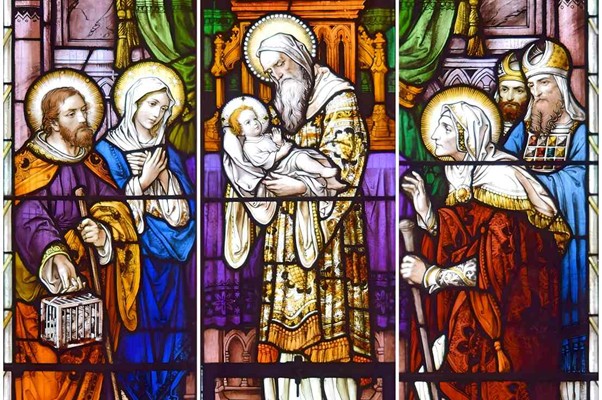This Sunday, the lectionary offers us an alternative gospel reading, because it’s also the day of the “Feast of The Presentation of the Lord.” The passage is Luke 2:22-40. The English Standard Version supplies it with the heading “Jesus Presented at the Temple.”
On feast days, churches celebrate special moments in the story of salvation. The best-known feasts are Christmas and Easter, but there are many more. When a feast falls on a Sunday, the lectionary offers an alternative reading.
In today’s alternative text, we read that when Jesus was about 6 weeks old, his parents brought him to the Jerusalem Temple. They presented him to God. They offered the least costly of the prescribed sacrifices. They heard from Simeon and Anna. They were amazed by what they heard.
Why does Luke include this account? What should we take away from it?
Luke puts much effort into indicating that Joseph, Mary, Simeon, and Anna were ritually observant. Righteous. Expectant. He told us earlier why God chose Mary to bear Jesus, He told us about her song, the Magnificat, a song of awe and expectancy.[1]
Luke also told us earlier about righteous Zechariah’s Temple encounter with the angel Gabriel before the birth of his son John Baptist, and his song after John was born. Also, a song of awe and expectancy.
Luke fills the opening pages of his gospel with Jews who sensed that God had begun the long-promised final solution to the problem of sin. The lamb of God had cone. The kingdom of God was inaugurated.
In today’s passage, the promises are most evident in Simeon’s song. It draws extensively from chapters 40-66 of the book of Isaiah.[2] A book completed about 600 years before Jesus was born.
Luke wants us to see Simeon as a student of the scriptures. He wants us to see Simeon as a person who longs for God’s word to be fulfilled. He wants us to see Simeon as a person who keeps in step with the Spirit.
Therefore, he tells the story as a rendezvous. He tells it as a meeting choreographed by God. The Law embedded in God’s word brought Joseph, Mary, and Jesus to the Temple. The Spirit of God brought Simeon and Anna to the Temple at the same moment. And there’s irony in it.
The Temple was the centre of sacrifice, the centre of Jewish faith. The lamb’s parents brought him to the Temple. The Temple was the meeting point of all Jews, including the best, most God-pleasing Jews. Non-Jews, Gentiles, were forbidden from entering the Temple.
Yet, it’s in the Temple that God says, through the God-pleasing Simeon, that salvation is for the Gentiles also, for Simeon’s song includes the words “a light for revelation to the Gentiles.”
About 40 years from that day, the Temple would be utterly destroyed.
Paul, the learned Jewish apostle to the Gentiles, Paul who turned from persecutor to promoter of Christ, would soon write to the Galatian church:
“There is neither Jew nor Greek, there is neither slave nor free, there is no male and female, for you are all one in Christ Jesus. And if you are Christ’s, then you are Abraham’s offspring, heirs according to promise.” (Galatians 3:28-29)
Do you see what Luke, the companion of Paul did in his account of the presentation of the Lord?
He included Simeon, a man, and Anna, a woman. Luke was transformed by the gospel of Jesus Christ which he absorbed from the early church. He “saw” what God did when he caused both Simeon and Anna to meet and greet the infant Jesus. God broke the gender barrier.
Notice there’s a virgin, a widow, and a bridegroom. Mary was a virgin till she gave birth to Jesus. Anna was a widow. In chapter 5, in verse 34, Luke will tell us that Jesus referred to himself as the bridegroom. A prophecy of Isaiah was fulfilled:[3]
“… the reproach of your widowhood you will remember no more.
For your Maker is your husband,
the Lord of hosts is his name;
and the Holy One of Israel is your Redeemer.”[4]
Luke is also using Simeon’s words to tell us that Jesus will divide people. People will either be for him or against him. Mary’s heart will break. Luke puts us on notice that the story of Jesus is a story of response. After reporting much of Jesus’ life, he’ll tell us Jesus was a stone of stumbling.[5]
What are we to take away from the passage?
I think the answer is amazement. Amazement at the material poverty of Mary and Joseph. Amazement at the faith, discipline and expectation of Mary, Joseph, Simeon, and Anna. Amazement that we can choose to be on the right side of God’s plan for saving the world.
You may like to know that a year ago, I wrote a column on the same passage. I titled it “Two more witnesses to Jesus.” In it I touch on some political features of the passage, and the gospel of Luke.
Peace be with you.
[1] I’ve mentioned the Magnificat several times in previous columns.
[2] See especially verses 40:5; 42:6; 46: 13; 49:6; 52:10; 56:1; 60:1.
[3] For this insight, I’m indebted to Bible scholar Pablo T Gadenz.
[4] Isa 54:4d–5c; for references to bridegroom and redeemer, see 62:4–5, 12
[5] See Luke 20:17-18, which echoes Isaiah 8:14-15.
To learn more about Rama, click here.


